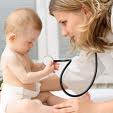الجوهرة المصونة
*****




المشاركات : 17164
العمـر : 36
تعاليق : مشرفة الطب والصحة
المزاج : 
الدولة : 
المهنة : 
الهواية : 
التسجيل : 10/10/2008
النقاط : 18248
التقييم : 501

 
توفيقك يارب

 |  موضوع: acute bronchiolitis موضوع: acute bronchiolitis  السبت أغسطس 07, 2010 12:28 pm السبت أغسطس 07, 2010 12:28 pm | |
| Bronchiolitis
Definition
Bronchiolitis is an acute viral infection of the small air passages of the lungs called the bronchioles.
Description
Bronchiolitis is extremely common. It occurs most often in children between the ages of two and 24 months, with peak infection occurring between three and six months of age. About 25% of infants have bronchiolitis during their first year, and 95% have had the disease by their second birthday. In temperate climates, bronchiolitis peaks from winter to late spring. In subtropical climates, the disease peaks from October to February.
Children who attend daycare or who live in crowded conditions and those who are exposed to second-hand smoke at home are more likely to develop bronchiolitis. Premature infants and children born with heart and lung defects or HIV/AIDS are more likely to have severe, life-threatening infections. Bronchiolitis occurs more often in boys than girls, with boys being hospitalized at 1.5 times the rate of girls. Bronchiolitis is a significant cause of respiratory disease worldwide. The World Health Organization (WHO) has funded research to develop a vaccine against the disease, but thus attempts have been unsuccessful.
Causes and symptoms
Bronchiolitis is caused by several different viruses. The most common of these is respiratory syncytial virus (RVS), which is responsible for about 100,000 hospitalizations of children under age four each year. Two subtypes of RSV have been identified, one of which causes most of the severe bronchiolitis infections. In addition, bronchiolitis can be caused by influenza, parainfluenza, and adenoviruses, all of which are common from fall through spring. These viruses are spread in tiny drops of fluid from an infected person's nose and mouth through direct contact, such as shaking hands, or kissing. The viruses can also live several hours on countertops, toys, or used tissues and easily infect people who handle contaminated items. The time from infection to the appearance of symptoms varies from two to seven days.
Key terms
Bronchiole — A thin air passage in the lung that branches off a larger airway.
Congenital — A condition that an individual is born with.
Bronchiolitis affects individuals differently depending on their age. In adults, older children, and some infants, bronchiolitis viruses causes symptoms similar to a mild cold—runny nose, stuffy head, and mild cough. The lungs are not involved, and these symptoms clear up without any medical treatment. In some children under age two, the cold-like upper respiratory symptoms worsen after a day or two. The lung tissue begins to swell and produce mucus, and the cells lining the bronchioles begin to slough off into the air passages. As the airways narrow from swelling, and mucus accumulation, breathing becomes difficult, and the child makes a wheezing or whistling sound with each breath. Lung involvement can occur quite rapidly.
The most common signs of bronchiolitis involve the infant's struggle to breathe. The child may take 50-60 breaths per minute and may develop brief periods when they stop breathing (apnea) and begin to turn blue (cyanosis). This occurs most often in babies who were born very prematurely or who are under six weeks of age and babies with congenital heart and lung problems and compromised immune systems. Babies may also stop eating, because it is becomes difficult for them to swallow and breathe at the same time. They may have a low fever, cough, and vomiting.
Diagnosis
Bronchiolitis is usually diagnosed through a physical examination by a pediatrician or family physician. The physician often finds an increased heart rate, rapid, labored breathing, and crackles in the lungs when the child inhales. Signs of ear infection (otitis media) and throat infection (pharyngitis) are sometimes present.
Although laboratory tests are available that can within in a few hours confirm the presence of RSV, these tests are not routinely necessary. The oxygen level in the blood may be measured through pulse oximetry in babies who are having difficulty breathing. Inadequate oxygen in the blood is an indication that hospitalization is necessary. Chest x-rays may be done on severely ill children to rule out other conditions.
Treatment
The degree of respiratory distress determines treatment. Individuals with mild symptoms are treated as if they have a cold with rest, fluids, and a cool air humidifier. Babies who are struggling to breath may hospitalized and given supplemental humidified oxygen. Their breathing will be monitored and if necessary fluids will be given intravenously to prevent dehydration. Occasionally infants need mechanical ventilation to fill and empty the lungs until the airways open.
Those children with compromised immune systems from diseases such as congenital HIV/AIDS and transplant patients are at highest risk for severe infections, serious complications, and death. Children with congenital heart and lung disorders are also at higher risk, as are infants under six weeks old. These high risk children may be admitted to pediatric intensive care units and treated with ribvarin (Virazole), a drug that keeps the virus from reproducing. This drug is reserved for the most critical cases.
Alternative treatment
Although there are alternative treatments for cold symptoms, such as echinacea and zinc, parents should consult their health practitioner about the appropriateness of using these treatments in very young children.
Prognosis
The majority of children who get bronchiolitis, even severe infections, recover without complications in one to two weeks, although fatigue and a light cough may linger longer. About 60% of people develop only cold-like symptoms without lung involvement. However, the disease accounts for about 100,000 pediatric hospitalizations and 4,500 deaths each year. Deaths usually occur because medical care is not sought soon enough.
Although many viral illnesses, like chicken pox, can be contracted only once, after which individuals develop immunity, people can get bronchiolitis multiple times. However, after the first infection, the symptoms are usually mild.
Prevention
The viruses that cause bronchiolitis spread very easily, making prevention difficult. Common sense measures such as frequent hand washing and keeping children away from crowds and sick individuals are only partially effective. Certain very high risk babies can be treated during the peak virus season with monthly injections of antiviral immunoglobulins to protect against RSV infection. These injections cost several thousand dollars per child per season and are reserved for children whose life could be at risk if they became infected. Antiviral immunoglobulins are used only for prevention and are not effective as a treatment once the infection has been acquired. | |
|
نورس
*********




المشاركات : 30951
العمـر : 94
تعاليق : مؤسس منتدى النورس
المزاج : 
الدولة : 
المهنة : 
الهواية : 
التسجيل : 09/10/2008
النقاط : 39243
التقييم : 1559

 
 |  موضوع: رد: acute bronchiolitis موضوع: رد: acute bronchiolitis  الخميس أغسطس 12, 2010 1:51 pm الخميس أغسطس 12, 2010 1:51 pm | |
|
يسلموا جوهرة القصر
يعطيكِ العافية يااااااارب
| |
|
عاشقة الزهور
*****




المشاركات : 75737
العمـر : 41
المزاج : 
الدولة : 
المهنة : 
الهواية : 
التسجيل : 09/03/2009
النقاط : 101796
التقييم : 846
 |  موضوع: رد: acute bronchiolitis موضوع: رد: acute bronchiolitis  الجمعة أغسطس 13, 2010 8:09 am الجمعة أغسطس 13, 2010 8:09 am | |
| | |
|
الجوهرة المصونة
*****




المشاركات : 17164
العمـر : 36
تعاليق : مشرفة الطب والصحة
المزاج : 
الدولة : 
المهنة : 
الهواية : 
التسجيل : 10/10/2008
النقاط : 18248
التقييم : 501

 
توفيقك يارب

 |  موضوع: رد: acute bronchiolitis موضوع: رد: acute bronchiolitis  الثلاثاء أغسطس 24, 2010 10:24 am الثلاثاء أغسطس 24, 2010 10:24 am | |
| | |
|





